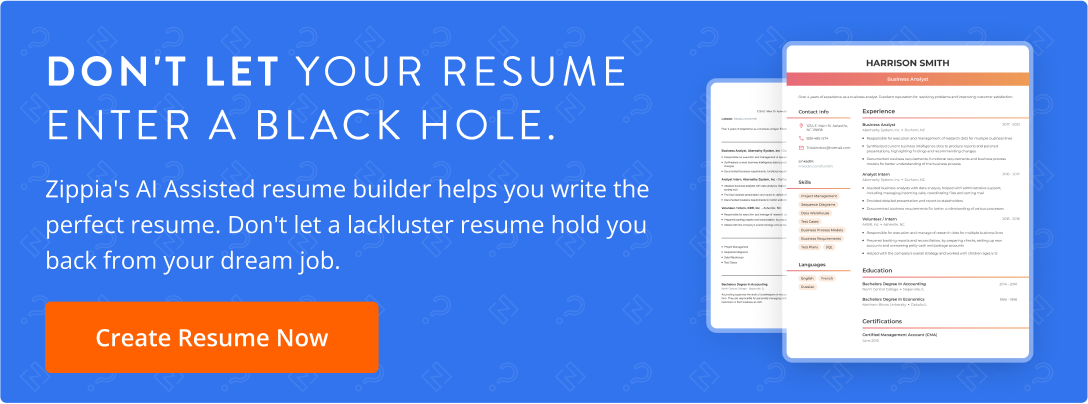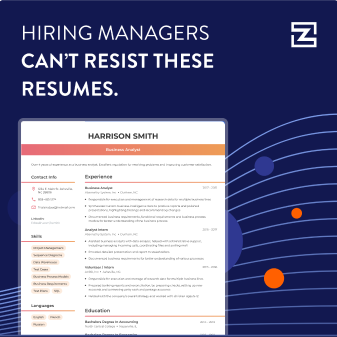How To Put Projects On A Resume (With Examples)
Summary. To put projects on your traditional chronological resume, include a separate projects section beneath the education or work experience section. In a project based resume, rename the work experience section to be named “projects” and you can avoid the standard chronological resume format and instead focus on your most relevant projects and professional skills.
- You can work projects into your work history section, organize your resume around your projects, or create a separate section for your projects.
- You should list your most relevant projects first and leave off any irrelevant projects.
- Freelancers, entry-level job candidates, and people who are changing career paths could benefit most from project-based resumes.

In This Article
Skip to section
- How to List Projects on a Resume
- Examples of Ways to List Projects On a Resume
- Tips for Listing Projects on a Resume
- Why Should You Put Projects on a Resume?
- What Is a Project-Based Resume?
- Who Should Use Project-Based Resumes?
- Putting Projects on a Resume FAQ
- Final Thoughts
- References
- Sign Up For More Advice and Jobs
How to List Projects on a Resume
To list projects on a traditional chronological resume, you should include a separate projects section beneath the education or work experience portion of your professional resume. This can be easily accomplished by including a “key projects” section below the bullets detailing your previous job responsibilities and accomplishments.
Listing projects on a traditional date-ordered resume can be a great option for professionals who want to showcase their project management expertise while also detailing their prior work titles and chronological job experience.
If you’re looking to ditch your traditional chronological resume altogether, a project-based resume is a great way of showcasing your most desirable professional skills outside of the tight confines of a standard cookie-cutter resume that lists your work experience in reverse chronological order.
By renaming the “work experience” section of your resume to “projects,” you can easily avoid the standard chronological resume format and instead focus on your most relevant projects and professional skills. This unique structure focuses more on practical, hands-on experience and less on how long you held a certain job title.
To list projects on a resume:
- Contextualize the project’s details. You don’t want each project to take up too much space, but you do need to describe the key who, what, where, when, and why of the story. Most importantly, bring in numbers as often as possible. While it’s especially important to provide data around the results, even including other figures, like the number of team members involved, the pace of the project, or the interdepartmental scope can all help a hiring manager understand the project’s details better.
- Highlight your accomplishments. “Ideally, your resume is a list of achievements,” says resume expert Don Pippin. When describing your projects, be sure that the direct impact that you had on the end result is apparent.
- Tailor your resume for each job. Again, this applies to all resumes, not just project-based ones. In the context of projects, though, be sure to think about how each entry relates to the specific job you’re applying for. Additionally, sometimes a project might be worth including on multiple applications, but the language you use can still be optimized based on the particular job description. Keywords are important for getting past applicant tracking systems, so don’t skip this step!
- Provide examples. If you’re emailing your resume, including some hyperlinks to documents relating to past projects can be really impactful. Not only can the hiring manager see the results of your work, but also how you and your team approached projects in general. This can be just the thing to clinch your candidacy, as it’s a rare treat for hiring managers to actually see examples of your past performance.
Examples of Ways to List Projects On a Resume
Below are three examples of ways you can list projects on your professional resume or CV. Using these examples as a template when writing your job-specific resume can help you advance in the hiring process and land the job of your dreams.
Listing Projects in the Education Section of Your Chronological Resume Example:
Education
Massachusetts Institute of Technology | Cambridge, Massachusetts
B.S. in Mechanical Engineering, May 2020 | GPA: 3.8 Key Projects: Led a team of three engineering students to execute blueprints and coordinate the production of state-of-the-art air filtration systems for the university hospital. Production and installation came in 12% under budget and were completed 2 weeks ahead of schedule.
Work Experience
- Drove revenue by 13% year-over-year by initiating increased customer engagement policy
- Oversaw a team of five cashiers, who collectively processed average credit card and cash payments of over $20,000 daily
Professional Project Highlights
- Developed and coded a complex app, compatible with iPhone and Android devices, designed to help hikers locate free campsites in their area.
- Increased digital revenue stream by 55% following launch
- Built a multifunctional website with a complex ordering system using HTLM 5, CSS, and bug-free code
- Managed all custom graphics, page composition, and branding for this client, leading to a 30% Q/Q jump in sales
Tips for Listing Projects on a Resume
If it’s your first time listing projects on a resume or ditching your traditional chronological resume or project-based one, there are a few things you need to keep in mind to craft an effective resume and impress hiring managers.
By following these five tips, you’ll be able to perfectly listing projects on your professional resume and allow your key skills and job qualifications to shine.
- Lead with the most relevant projects. One of the biggest advantages of a project-based resume is having the ability to list your work experiences and skills in order of the most relevant projects, instead of arranging them chronologically. Since most hiring managers typically only spend a few minutes, or even seconds, reviewing applicant’s resumes, leading with your most relevant projects is a great way to make a good first impression and advance in the hiring process.
- Highlight leadership and job-specific skills. If you’re listing projects on your resume, it’s important to be deliberate and meticulous in the projects you include. Your project list should be presentable, professional, and perfectly convey your leadership and job-specific skills. Make sure to always closely read job descriptions and tailor your project-based resume to the specified skills required for the role. Discussing your most relevant projects will allow you to expertly highlight your project management and technical skills and sell yourself as the best applicant for the job.
- Show how you achieve results and meet company goals. Another substantial perk of listing projects on your resume is the ability to clearly illustrate and verify how you are results-driven and ready to meet company goals. Discussing how you helped your previous company grow, fulfill corporate accomplishments, and achieve profitable outcomes will notably increase your hireability and help you market yourself as the best fit candidate for the job.
- Illustrate how your experiences align with company values. Not only is it important to showcase the skills and qualifications required for a job opening, but it’s also essential to illustrate how your work style and professional goals align with the values a company prides itself on. Using the projects listed on your resume to convey your personality and show how you’d fit in with their corporate culture and abide by company values can significantly increase your chances of getting called in for an interview and eventually getting hired.
- Keep project descriptions short. To emphasize your strongest skills and professional abilities, it’s important to keep project descriptions short, concise, and to the point. Providing only the essential details to demonstrate your skills, achievements, and experience will allow hiring managers to easily read and review your resume.
Why Should You Put Projects on a Resume?
Listing projects on your resume will help you get a leg up over other qualified competing applicants.
A project-based resume, similar to a functional resume, is highly effective in conveying your unique qualifications, work style, field of specialization, and areas of expertise.
Project-based resumes are great tools for illustrating hands-on experience and your decision-making and conflict resolution skills. Describing projects you’ve been involved with can give hiring managers a glimpse into how you operate as an employee.
Submitting a project-based resume with your job applications can allow you to position yourself as the best candidate for the role by highlighting and describing projects that closely align with the job description included in the advertisement.
Including a list of projects on your resume will allow your job application to shine and illustrate your work capabilities and well-rounded personality; to hiring managers and job recruiters.
What Is a Project-Based Resume?
A project-based resume is a professional resume that focuses on accomplishments rather than chronological job titles and previous work responsibilities.
Where a traditional resume lists work experience and academic degrees in date order, a project-based resume instead does one of two things.
It either lists a job seeker’s relevant academic, work, and personal projects in order of most to least compelling or includes specific projects beneath the education or work experience sections of a resume.
Project-based resumes effectively provide hiring managers and prospective employers with verifiable proof of a job applicant’s industry expertise, achievements, and experience.
Who Should Use Project-Based Resumes?
Anyone can use project-based resumes, but the following groups might find additional benefit:
- Freelancers. Project-based resumes can be an especially worthwhile option for freelancers, as it allows you to ditch the traditional chronological resume and instead focus on projects you have worked on that are most relevant to the position you’re applying to.
- Entry-level candidates. Not only is a project-based resume a great alternative for freelance workers, but it can also be equally as enticing for traditional employees or recent graduates since projects can be easily listed beneath education and work experience sections, as you would normally list accomplishments, skills, and previous job responsibilities.
- Career changers. Writing a project-based resume can be a great option for people looking for their first job, changing careers, coming off a long sabbatical or personal leave, or searching for a full-time job after a series of freelance gigs.
- Should I put my projects on my resume? Yes, you should put your projects on your resume. Listing a few of your most impressive professional projects on your resume can help hiring managers see what you’re capable of. In addition, if you’re a freelancer or a recent college graduate, most of your work experience will be projects.
- What kind of projects should I put on my resume? You should put successful, professional projects that relate to the job you’re applying for on your resume. Think of a few of the projects that demonstrate the skills that are listed on the job description you’re applying for and put them on your resume. Don’t list projects that have nothing to do with your professional goals or that didn’t go well. These won’t do anything but take up precious space on your resume, and they may even hurt your chances of being invited to an interview.
- Do personal projects count as experience? No, personal projects don’t count as experience. They don’t usually count as formal work experience, but that doesn’t mean you shouldn’t put some of them on your resume, especially if they demonstrate your professional skills. Just be sure to mark them as personal projects so that it doesn’t look like you’re trying to pass them off as work experience.
- is it OK to put project details in a resume?Yes, It’s OK to put project details in a resume. Projects are a great addition to your resume when your experience section doesn’t already show that you have the background or experience for a job. Recent graduates or entry-level candidates are the ones who typically put projects on their resume.
Final Thoughts
Whether you’re a freelancer or a traditional employee, a recent graduate or a career changer, projects can make your resume pop.
By illustrating your hands-on work experience, verifying your skills and job qualifications, and marketing yourself as the best candidate for the role, you’ll have hiring managers who can’t wait to call you in for an interview to learn more.
Using the tips and templates included in this article can help you write a well-structured and effective project-based resume and make a great first impression on recruiters across industries.
References
How useful was this post?
Click on a star to rate it!
Average rating / 5. Vote count:
No votes so far! Be the first to rate this post.
Articles In Resume Guide
Resume Tips
- Resume Tips
- Best Resume Writing Services
- Things To Avoid On A Resume
- Resume Paper To Use
- What To Include In A Resume
- How To Write A Bio
- How To Write A Personal Statement
- Lied on Your Resume?
- Resume PDF
- Avoid Age Discrimination
- Words and Phrases You Shouldn't Include in Your Resume
- How Many Skills Should You List On A Resume
- Send A Resume As A Pdf
- Resume Critique
- Make A Resume Stand Out
- Resume Spelling
- Resume Past Or Present Tense
- How To List Projects On A resume
- Best Resume Action Words
- How To Quantify Your Resume
- Resume Bullet Points
- Are Resume Writers Worth It
- How Many Jobs To List On Resume

Elsie is an experienced writer, reporter, and content creator. As a leader in her field, Elsie is best known for her work as a Reporter for The Southampton Press, but she can also be credited with contributions to Long Island Pulse Magazine and Hamptons Online. She holds a Bachelor of Arts degree in journalism from Stony Brook University and currently resides in Franklin, Tennessee.


Create Resume





